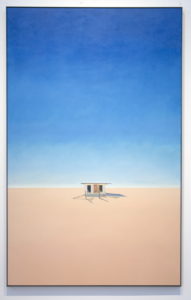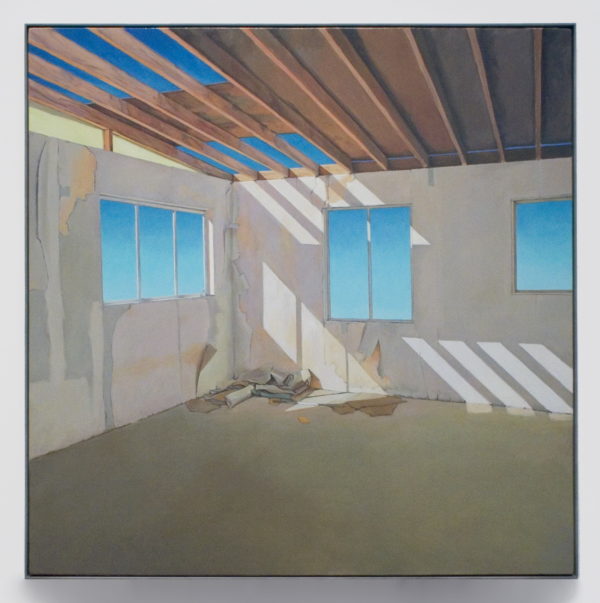The vast, empty expanses of the southern California landscape, whether desert vistas or sprawling webs of highways, have long fascinated artists. John Divola photographed a moldering beach house in Zuma and an “Isolated House” series of desert abodes while Ed Ruscha captured lonely gas stations, apartment buildings and parking lots; David Maisel focused on Owens Lake, Kim Stringfellow on the Mohave Desert. Similarly, Deanna Thompson, who lived in the Yucca Valley for thirty years, was inspired by the endless horizons and abandoned buildings that dotted the bleakly beautiful landscape. The paintings from the last years of her life (Thompson died in 2015) currently at Kayne Griffin Corcoran use different modes to meditate on the boundaries between exterior and interior and how private spaces can represent the individual mind.
The “Desert House” series is characterized by capacious canvases, divided in the middle by serene but saturated washes of monochromatic paint. At the center of each work is a diminutive, rundown structure set far back on the horizon line. Most feature nothing else—only cloudless sky, tiny shack, dirt. Intense light suffuses most works but the effect is almost unsettling. Desert House 2010 #23 (2010), Desert House 2013 #10 (2013), and Desert House 2011 #5 (2011) are lonely and isolated edifices, struggling to provide refuge from the elements; Desert House 2011 #15 (2011)’s light is an eerie, algae green. Many of the inhabitants seem to have given up completely—in Desert House 2014 #9 (2014) the façade of the house is stripped away and only minuscule, exquisitely painted piles of trash remain. The level of detail in the houses—the trash, delicate wildflowers, rickety doors—beguiles, especially amidst canvases so vast à la Rothko that they swallow one up.

Deanna Thompson, Desert House 2010 #23, 2010. ©Deanna Thompson, courtesy of Kayne Griffin Corcoran.
Thompson clearly delights in the physicality of painting, both in grand sweeps of the brush and her tiny, precise marks. In the “Light Fixtures” series each canvas is again divided into two monochromatic squares of color to represent ceiling and wall, and an exquisitely rendered ceiling light is affixed near the top of the ceiling.
The lights are decidedly retro, their glass bowls and kitschy decorative elements perhaps once luxurious but now outmoded. Thompson’s loving attention to detail in these domestic mainstays makes the works feel intimate and familiar. However, the artificial light that permeates the canvas is slightly disconcerting, and the upwardly tilted perspective distances the viewer; the fixtures in their faded glamour are akin to portraits of careworn individuals.
The desert houses and light fixtures, along with Untitled (2013), a portrait of a woman in a bathtub, several paintings of outdated cars, and Interior #1 (2011), which features the inside of a crumbling space complete with detritus and a roof with shorn panels, are depictions of intimate, fragile spaces that barely withstand the pressures of the exterior world. In this sense they are proxies for the human mind beset by melancholy, stress, and the pressures of modern life. The refuges are tenuous ones, capable of infiltration or collapse.


